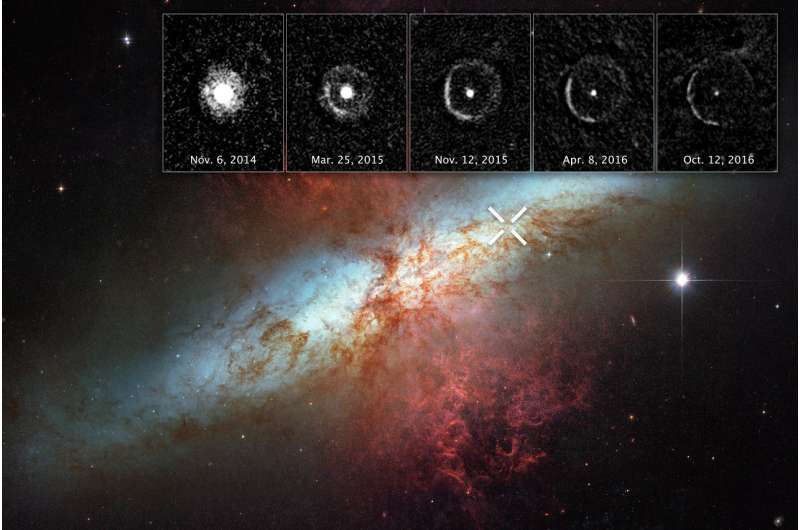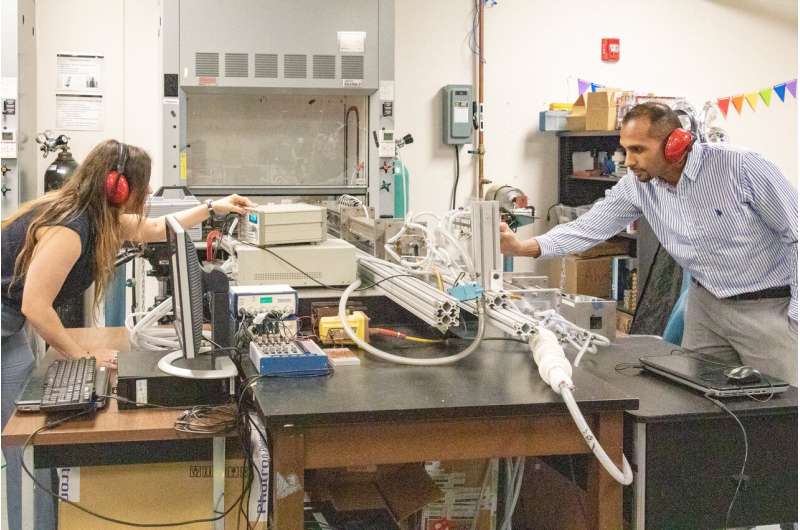New study sheds light on conditions that trigger supernovae explosions (Update)

Understanding the thermonuclear explosion of Type Ia supernovae—powerful and luminous stellar explosions—is only possible through theoretical models, which previously were not able to account for the mechanism that detonated the explosion.
One of the key pieces of this explosion, present virtually in all models, is the formation of a supersonic reaction wave called detonation, which can travel faster than the speed of sound and is capable of burning up all of the material of a star before it gets dispersed into the vacuum of space.
But, the physics of the mechanisms that create a detonation in a star has been elusive.
Now, a team of researchers from the University of Connecticut, Texas A&M University,University of Central Florida, Naval Research Laboratory, and Air Force Research Laboratory has developed a theory that sheds light on the enigmatic process of detonation formation at the heart of these remarkable astronomical events.
The research, published Nov. 1 in Science, offers a critical understanding of this physical process both in stars and also in chemical systems on Earth. It was led by Alexei Poludnenko, UConn School of Engineering and Texas A&M University; in collaboration with Jessica Chambers and Kareem Ahmed, the University of Central Florida; Vadim Gamezo, the Naval Research Laboratory; and Brian Taylor, the Air Force Research Laboratory.
For the first time, researchers were able to demonstrate the process of detonation formation from a slow subsonic flame using both experiments and numerical simulations carried out on some of the largest supercomputers in the nation. They also successfully applied the results to predict the conditions of detonation formation in one of the classical theoretical scenarios of Type Ia supernova explosion.
Type Ia supernovae explosions happen when carbon and oxygen packed to a density of around 1,000 tons per cubic centimeter in the stellar core burn in quick, thermonuclear reactions. The resulting explosion disrupts a star in a matter of seconds and ejects most of its mass while emitting an amount of energy equal to the energy emitted by the star over its entire lifetime.
Typically, in order to form a detonation, burning must occur in a confined setting withwalls, obstacles, or boundaries, which can confine pressure waves being released by burning.
As pressure rises, shock waves form, which can grow in strength to the point when they cancompress the reacting mixture igniting it and producing a self-sustaining supersonic front. Stars do not have walls or obstacles, which makes the formation of a detonation enigmatic.
In this study, the team developed a unified theory of turbulence-induced deflagration-to-detonation that describes the mechanism and conditions for initiating detonation both in unconfined chemical and thermonuclear explosions.
According to the theory, if one takes reactive mixture, which burns and releases energy, and stirs it up to create intense turbulence, a catastrophic instability can result and would rapidly increase pressure in the system producing strong shocks and igniting a detonation. Remarkably this theory predicts the conditions for detonation formation in Type Ia supernovae.

Researchers were able to gain insight into the fundamental aspects of the physical processes that control supernovae explosions because thermonuclear combustion waves are similar to chemical combustion waves on Earth in that they are controlled by the same physical mechanisms.
Because of the similarities, the findings may be applied to various terrestrial combustion systems in which detonations can form, such as the context of industrial accidents involving gaseous explosions, as well as novel propulsion and energy conversion applications, such as detonation-based engines.
More information: Alexei Y. Poludnenko et al, A unified mechanism for unconfined deflagration-to-detonation transition in terrestrial chemical systems and type Ia supernovae, Science (2019). DOI: 10.1126/science.aau7365
Journal information: Science
Provided by University of Connecticut





















